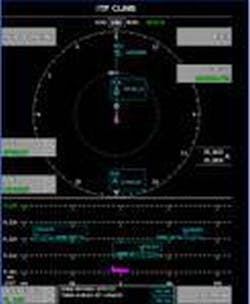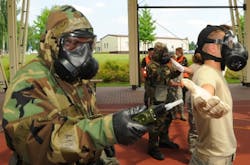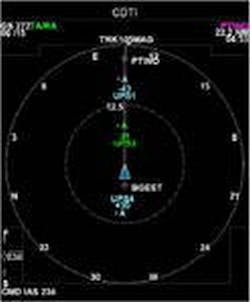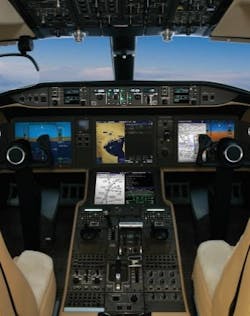“NextGen, and for that matter SESAR, are evolving to include higher performance capabilities to deal with more complex operations and airspace. The core premise behind NextGen and SESAR is that they support a performance-based evolution.” explains Rick Heinrich, director of strategic initiatives for avionics specialist Rockwell Collins in Cedar Rapids, Iowa.
“There are several pieces that must come together for Europe's SESAR and NextGen to work -- equipage in the airplanes, rules and protocols, and regulatory cooperation between different countries, says Mike Madsen, president of space and defense for Honeywell Aerospace in Phoenix. The last part will be the most difficult, he adds.
SESAR and NextGen must have similar rules and standards just to help with pilot training, Madsen points out. The airlines are anxious about this, but in the end it should be implemented, he continues.
“To be clear, NextGen and SESAR are not specific equipment implementations,” Heinrich continues. “They are part of a system of systems that enable change. “Required Navigation Performance or RNP airspace was the first step in that performance-based environment. ADS-B Out is the next enabler and we are already working on the first elements of ADS-B In which will provide even more capabilities.
Many different programs are in progress under NextGen and SESAR, but the key technology program driving satellite-based navigation is Automatic Dependent Surveillance-Broadcast (ADS-B). Earlier this year the FAA's 2012 total budget request was $1.24 billion -- $372 million higher than 2010 enacted levels, or more than a 40 percent increase. Proposed 2012 FAA funding for ADS-B technology is $285 million, up from $200 million in 2010.
The FAA mandates that all aircraft flying in classes A, B, and C airspace around airports and above 10,000 feet must be equipped for ADS-B by 2020.
ADS-B will enable an aircraft to determine its position with precision and then broadcast its position, along with speed, altitude, and heading to other aircraft and air traffic control at regular intervals, says Cyro Stone, the ADS-B/SafeRoute programs director at Aviation Communication & Surveillance Systems (ACSS) in Phoenix, a joint venture company of L-3 Communications & Thales. ADS-B has two parts -- ADS-B In and ADS-B Out, he says.
Where pilots will see the most improvements in situational awareness is with ADS-B In, which refers to the reception by aircraft of ADS-B data. ADS-B In is in contrast with ADS-B Out, which is the broadcast by aircraft of ADS-B data. ADS-B In will enable flight crews to view the airspace around them in real-time.
ADS-B data broadcasts on a radio frequency of 1090 MHz and is compatible with the transponders used for the Traffic Collision Avoidance System (TCAS), Stone says. For the general aviation community, the ADS-B data link is 978 MHz, often called the Universal Access Transceiver (UAT) link.
The FAA’s ruling requires that all aircraft be equipped with the 1090 transponder by 2020 and that the transponder meet performance standards under the FAA’s DO-260B safety certification standard.
ACSS is working with US Airways and the FAA to bring ADS-B Out and In to the US Air fleet of Airbus A330 aircraft, Stone says. The work with US Airways will address efficiencies of their A330 fleet that flies from Europe to Philadelphia to improve flying efficiencies over the North Atlantic and become more efficient when landing at Philadelphia, Stone says.
The company also is working with JetBlue to implement ADS-B on that airline's Airbus A320 aircraft, he adds. The JetBlue application will use the XS-950 Mode S Transponder starting in 2012.
ADS-B and DO260B products are approaching production levels over the next year or so and will be made available, says Forrest Colliver, avionics integration lead at Mitre Corp. in McLean, Va. Virtually no ADS-B Out equipment has been installed yet in commercial aircraft, Colliver says.
Many narrow- and wide-body air transport aircraft have transponders and multi-mode navigation receivers, which should help them comply with the ADS-B Out rule through service bulletins or manufacturer exchange, Colliver says. The key issue with the new rule, he says, is how operators will ensure the quality of ADS-B position broadcasts. This refers to "positioning source," which aircraft and air traffic controllers use for safe separation and situational awareness. Position source also may be part of collision avoidance systems in the future.
“As with 1090 ES ADS-B Out, none of the aircraft equipped for ADS-B In meet the requirements of DO-260B; however, it is expected that avionics and airframe manufacturers will address modifications to these existing system as they define required ADS-B Out certification,” Colliver notes.
“Avionics has been evolving for the past several years,” says Rockwell Collins's Heinrich. “The Wide Area Augmentation System, or WAAS, enabled improved approach and landing capabilities providing more access to airports in a variety of degraded conditions. “What has been done in the new aircraft is establishing an architecture that supports incremental change with less intrusion,” Heinrich says. “In many cases new functionality is now a software upgrade to an existing processor or decision support tool. We are working to establish ways to minimize hardware and wiring changes when change is identified. A great example is our Pro Line Fusion avionics system.”
Today’s systems generally provide key information through the displays, Heinrich says. “This is how the pilot is informed of relevant information. This means that as systems evolve, displays need to evolve. As aircraft operate in high densities, new alerts are required. Let’s use TCAS as an example. When we changed the vertical separation using Required Vertical Separation Minimums (RVSM) we found that we had more TCAS alerts. While there was no compromise in safety, the design thresholds did not reflect the new operational limits.
“We can expect more of the same as we increase the precision of the system using RNP and ADS-B. Procedures for 1 mile separation are already in development. Terminal area operations will be even more “dense” and older alerts will need to be improved."
Rockwell Collins has several aircraft operating in RNAV and RNP airspace which is part of NextGen and SESAR, Heinrich says. “We have been part of the initial ADS-B Out applications for global operations. And in Europe we are a pioneer in the data communications program known as the Link 2000+ program."
The SafeRoute class 3 EFB NEXIS Flight-Intelligence System from Astronautics Corp. of America in Milwaukee, Wis., will fly on Airbus A320s and host applications such as traffic information, in-trail procedures, enhanced en-route situational awareness, and enhanced airport surface situational awareness. SafeRoute enables ADS-B-equipped aircraft to use fuel efficiently while flying over oceans, Stone says. Operators also can use SafeRoute-M&S (merging and spacing) to help aircraft line up for arrival and landing.
One of the biggest NextGen challenges avionics integrators face is retrofitting relatively old aircraft by integrating new technology with obsolescent systems and re-certifying software and hardware can create mountains of paperwork.
“It is one of the challenges, but I think it is important to realize that even the Airbus A350 and the Boeing 787 are already retrofit aircraft,” Heinrich says. “The system is evolving and the performance requirements are maturing. All of this will bring change, but the real issue is how the airspace will mature. A highly capable super aircraft would not benefit if it were the only highly capable aircraft. There needs to be a level of critical mass for an operation to evolve to a high performance level. Even new aircraft with new capabilities are not enough to change the airspace by themselves.”
It always is easier to start with clean slate on a new aircraft and be more efficient around system checks and “creating your own standard type certificates,” Stone says.
“There are more legacy aircraft than new aircraft, Heinrich continues. “Studies illustrate that for some operations 40 percent of all the aircraft need to have advanced capabilities for the procedures to work. It is very difficult to change arrival or departure operations one aircraft at a time. That is why there is so much work being done on stimulating change -- making benefits available to those that equip as early as possible. You may have heard of the FAA’s “Best Equipped -- Best Served” concept. That concept is intended to offer early benefits to those that step our early and equip.”
Best equipped, best served essentially gives priority to those aircraft that have the technology to approach and land in a more efficient manner, Stone says. Some in the industry roughly equate it to an HOV lane or FastLane toll booths.
Related stories
-- NextGen funding exceeds $1.2 billion in FAA's 2012 budget request;
-- SESAR program is right on track;
-- Airbus launches ProSky -- a new air traffic management subsidiary;
-- More changes announced under FAA air traffic control review; and







